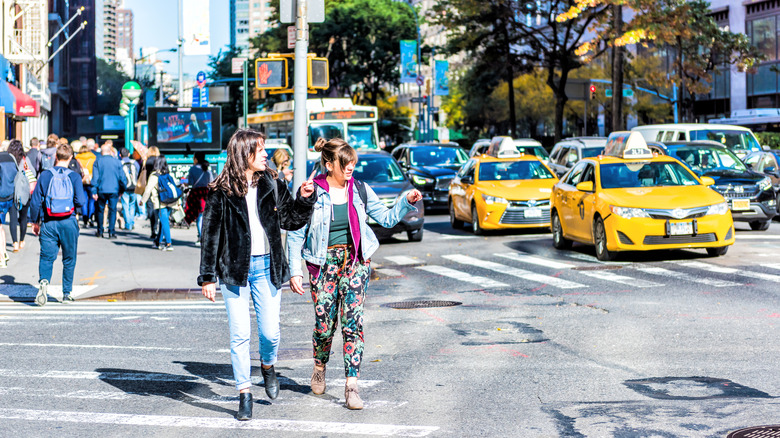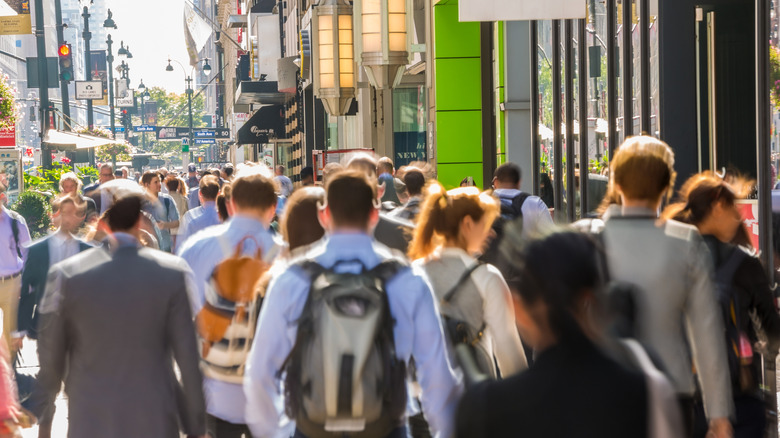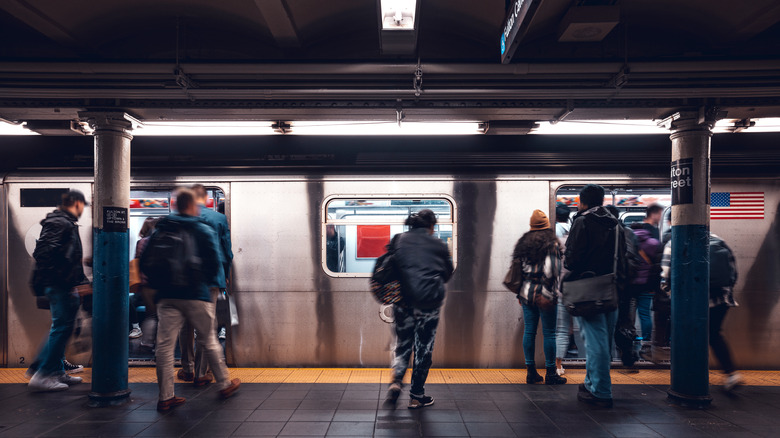The Unspoken And Unexpected Walking Rule To Blend In Like A Local In New York City
Strolling through the streets of a new city or country is one of the most exciting experiences of traveling. The simple act of walking allows travelers to take in the culture, find random hidden gems, interact with the locals, and get the gist of the vibes the city has to offer. Forget about using Google Maps to get to your destination and take advantage of walking aimlessly through the streets instead.
New York City is one of the most popular destinations in the U.S., welcoming visitors from all over the globe — so it is very easy to fall into some common tourist traps or mistakes and instantly be labelled as a tourist. Every city, country, or state has unwritten rules to get familiar with and tips to help you blend in, so here's one for the next time you're in New York City: Keep in mind that in this fast-paced city, you don't have to wait for the crosswalk signal to cross the road. In fact, jaywalking is so common that as of October 2024, it is no longer illegal, and the previous $250 fine has been scratched. "Let's be real: jaywalking is a way of life in New York City," Brooklyn-based city council member Mercedes Narcisse told NPR. "It's how people navigate our city." And if you're driving in New York, watch out for jaywalkers because they are literally everywhere.
Tips to jaywalk like a local in NYC
Two things you'll notice when walking in NYC is how crowded the pavements are, and the sense of urgency many pedestrians have. In fact, you'll realize that the pace of New Yorkers is much faster than the average person. Both of these factors contribute to the ubiquitousness of jaywalking in the city. The packed pavements cause congestion, making it difficult for people to get to their appointments on time. As a result, pedestrians cross in the middle of the street, against the light, and walk among the traffic to speed up the process — even if that means dodging taxis and bikes. As it led to accidents and even fatalities, penalties were enforced starting in 1958, with a possible $250 fine issued for anyone caught jaywalking. But as more and more New Yorkers ignored the rule, the city council finally decided to made it legal in 2024.
As a tourist wanting to blend in, there are tips to make jaywalking less risky. For starters, crossing at an intersection is safer, as cars are already wary and stop to see if any other vehicles, or people, are coming their way. Be sure to look right and left, instead of blindly following the person in front of you, and remember to watch out for e-bikes that literally come out of nowhere. If you're avoiding crowded sidewalks — or there is no sidewalk — choose to walk on the left side of the street, facing the traffic, so you can see the vehicles coming toward you. It's always best to stay as close to the curb as possible to minimize danger. Tourist or not, remember to always prioritize safety.
Unwritten walking rules when visiting New York City
As a tourist, there are other important unwritten rules to know when it comes to walking in this city — one of which is simply sticking to the right side of the pavement. Just like when going up the stairs or riding an escalator, the right side is where you should be. If you're in a hurry and want to pass the already fast-walking people, you should pass walkers on the left. It is quite similar to driving rules and helps create some kind of order amid the chaotic crowds. Needless to say, since everyone is walking so quickly, it's best to avoid sudden stops. Otherwise a domino effect can erupt, along with a lot of angry people. If you need to stop, be sure to step to the side, and do so without disrupting the rhythm. New Yorkers absolutely hate it when tourists stop abruptly to take a photo of a skyscraper or something that caught their attention.
There's also basic local etiquette when using public transportation, including stepping to the side of the subway door to allow people off the trains first, before you get on. Blocking the doors, pausing, or holding them open is quite frowned upon, as it can create chaos, preventing trains from moving and people from getting where they're going. By knowing these unspoken rules, you'll be able to integrate easily and avoid getting the cold shoulder from New Yorkers on the move.


